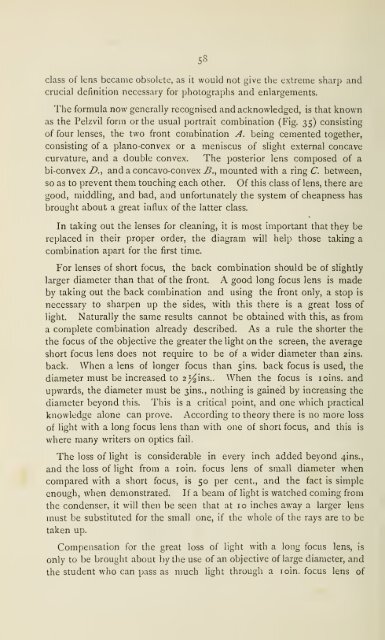58class <strong>of</strong> kns became obsolete, as it would not give the extreme sharp <strong>and</strong>crucial definition necessary for photographs <strong>and</strong> enlargements.<strong>The</strong> formula now generally recognised <strong>and</strong> acknowledged, is that knownas the Pelzvil form or the usual portrait combination (Fig. 35) consisting<strong>of</strong> four lenses, the two front combination A. being cemented together,consisting <strong>of</strong> a plano-convex or a meniscus <strong>of</strong> slight external concavecurvature, <strong>and</strong> a double convex. <strong>The</strong> posterior lens composed <strong>of</strong> abi-convex D., <strong>and</strong> a concavo-convex B., mounted with a ring C. between,so as to prevent them touching each other. Of this class <strong>of</strong> lens, there aregood,middling, <strong>and</strong> bad, <strong>and</strong> unfortunately the system <strong>of</strong> cheapness hasbrought about a great influx <strong>of</strong> the latter class.In taking out the lenses for cleaning, it is most important that they bereplaced in their proper order, the diagram will help those taking acombination apart for tlie first time.For lenses <strong>of</strong> short focus, the back combination should be <strong>of</strong> slightlylarger diameter than that <strong>of</strong> the front. A good long focus lens is madeby taking out the back combination <strong>and</strong> using the front only, a stop isnecessary to sharpen up the sides, with this there is a great loss <strong>of</strong>light. Naturally the same results cannot be obtained with this, as froma <strong>complete</strong> combination already described. As a rule the shorter thethe focus <strong>of</strong> the objective the greater the light on thescreen, the averageshort focus lens does not require to be <strong>of</strong> a wider diameter than 2ins.back. When a lens <strong>of</strong> longer focus than 5ins. back focus is used, thediameter must be increased to 2^ins.. When the focus is loins. <strong>and</strong>upwards, the diameter must be 3ins., nothing is gained by increasing thediameter beyond this. This is a critical point, <strong>and</strong> one which practicalknowledge alone can prove. According to theory there is no more loss<strong>of</strong> light with a long focus lens than with one <strong>of</strong> short focus, <strong>and</strong> this iswhere many writers on optics fail.<strong>The</strong> loss <strong>of</strong> light is considerable in every inch added beyond 4ins.,<strong>and</strong> the loss <strong>of</strong> light from a loin. focus lens <strong>of</strong> small diameter whencompared with a short focus, is 50 per cent., <strong>and</strong> the fact is simpleenough, when demonstrated.If a beam <strong>of</strong> light is watched coming fromthe condenser, it will then be seen that at 10 inches away a larger lensmust be substituted for the small one, if the whole <strong>of</strong> the rays are to betaken up.Compensation for the great loss <strong>of</strong> light with a long focus lens, isonly to be brought about by the use <strong>of</strong> an objective <strong>of</strong> large diameter, <strong>and</strong>the student who can pass as much light through a loin. focus lens <strong>of</strong>
59small diameter as through an objective <strong>of</strong> 4in. focus, must indeed havediscovered a royal road. No, it is all book theory <strong>and</strong> cannot be done;let the <strong>lantern</strong>ist try for himself.Unfortunately after the introduction <strong>and</strong> popularising <strong>of</strong> these largediameter lenses, by Pr<strong>of</strong>essor Maiden <strong>and</strong> Mr. Hughes, other lenses <strong>of</strong>large diameter appeared in the market, many <strong>of</strong> an inferior character,<strong>and</strong> the unwary at once conclude that so long as they have a largediameter combination, they will succeed in the best results, this doesnot follow, as some <strong>of</strong> these lenses are no better in definition than the2j^in. single achromatic.THE FOCUS OF THE LENS.Before the distance can be ascertained at which the <strong>lantern</strong> should beplaced for a given size picture, we must first know the optical orequivalent focus, a term which arises from comparison with a single lens,that produces the same size disc, <strong>and</strong> thus being equivalent to eachother, this can only be properly tested <strong>and</strong> found by the optician, butmay be roughly got at as follows :—Supposing the back focus <strong>of</strong> a lensis four inches <strong>and</strong> the tube it is mounted in is four inches also— halvethe length <strong>of</strong> the tube, <strong>and</strong> add this to the back focus, which wouldmean an equivalent focus <strong>of</strong> six inches— in other words, the equivalentfocus is measured from midway between the lens lube to the focussedimage.<strong>The</strong> plan generally adopted for marking the lenses, is that <strong>of</strong> the solaror back focus. A view is focussed up sharp by the lens on a white wallor paper, <strong>and</strong> the distance between the wall <strong>and</strong> the back lens measured,this is called the back focus, <strong>and</strong> measures from 3jins. upwards. Thisis <strong>of</strong> little service for determining the disc it will throw, <strong>and</strong> is a frequentsource <strong>of</strong> trouble. As two combination lenses may be taken, with theirsolar foci identical, when used on the screen they are considerably out,even to the extent <strong>of</strong> 2ft. on a twelve foot disc. <strong>The</strong> diameter <strong>of</strong> lens<strong>and</strong> length <strong>of</strong> tube it is mounted in, has to be considered, practicallythe back focus <strong>of</strong> a lens is no guide whatever, therefore no scale can bemade to help the operator.Having ascertained the equivalent focus <strong>of</strong> lens, the following scalewill be found very convenient, being copied by permission, from theOptical Lantern Journal, October, 1890 :—" When one is called upon to give a <strong>lantern</strong> entertainment in a hall orroom, the following questions will be uppermost in the mind <strong>of</strong> theoperator :—(i) What size <strong>of</strong> disc can be obtained with a lens <strong>of</strong> a certainfucus? (2) How far distant from the screen must the <strong>lantern</strong> be placedin order to get a disc <strong>of</strong> a certain size with a given lens <strong>of</strong> ascertained
- Page 1 and 2:
THEPROJECTIO,MA GIC LANTERN MANUAL
- Page 3:
OCSBLIBRAPY
- Page 7:
..INDEXA.Adjustment of a JclAlumini
- Page 10 and 11:
—increased by the aid of a powerf
- Page 12 and 13:
far back as 1811. Lanterns of the a
- Page 14 and 15:
mixadvisable to have a mahogany, or
- Page 16 and 17:
8A condenser can only take those ra
- Page 18 and 19:
There is a considerable difference
- Page 20 and 21:
12occasions, it is only necessary t
- Page 22 and 23: 14Triplexicon was first made it was
- Page 24 and 25: i6aid of two screws. The two slots
- Page 26 and 27: perfection, combustion, and purity,
- Page 30 and 31: 20back of lantern, in that case the
- Page 32 and 33: sumed, the flow should be adjusted
- Page 34 and 35: 24which is passed over the rod, and
- Page 36 and 37: 26gases to be shut off without dist
- Page 38 and 39: 28made in their get up. We have nev
- Page 41 and 42: 3tserve to distribute the same to t
- Page 43 and 44: (V>ao—IH
- Page 45 and 46: ;33the thing a study, and used such
- Page 47 and 48: V>-is:a
- Page 49 and 50: 35who designed the body of this lan
- Page 51 and 52: 37far back but equally flat to the
- Page 53 and 54: 39ceding one, therefore giving grea
- Page 55 and 56: 4tthe same as they do, in fact it i
- Page 57 and 58: —43reducing same as low as possib
- Page 59 and 60: 45With all three discs, as coincide
- Page 61 and 62: 47and the slides may be placed in a
- Page 63 and 64: 49inch and inch and-a-half screws,
- Page 65 and 66: SIshowing, gently push back the cov
- Page 67 and 68: 53sun rising and illuminating the p
- Page 69 and 70: 55large slides it was necessary to
- Page 71: 57A. Is a right angle prism, being
- Page 75 and 76: —6isize of disc can be produced.
- Page 77 and 78: —63COMPRESSED GASES.Compressed ga
- Page 79 and 80: 6sNO DANGER WITH GAS CYLINDERS,OR B
- Page 81 and 82: "67valves are of little use as a me
- Page 83 and 84: 69to reach our compressors without
- Page 85 and 86: ——71ascertain their bursting po
- Page 87 and 88: —73bottles black, and hydrogen (o
- Page 89 and 90: ;Having blown through every tube to
- Page 91 and 92: 77controlling the flow of compresse
- Page 93 and 94: 79The Duplex.—The chieffeaturecon
- Page 95 and 96: —8icarries the gas to the orifice
- Page 97 and 98: 83the above-mentioned tube, whilst
- Page 99 and 100: 8sTable for Ascertaining the Quanti
- Page 101 and 102: 87On no account use two separate bo
- Page 103 and 104: 89virtue, and if required to be use
- Page 105 and 106: 91In finishing up, turn out the hgh
- Page 107 and 108: 93good support in one sense— but
- Page 109 and 110: 95another takes its place without a
- Page 111 and 112: 97opposite side to that which he is
- Page 113 and 114: 99without doubt, this is the only t
- Page 115 and 116: lOIFig 56.SCREEN FRAMES.Considerabl
- Page 117 and 118: I03and hauled up. The pulley blocks
- Page 119 and 120: PRACTICAL HINTS TO INTENDING LECTUR
- Page 121 and 122: 107as well as the lecturer, a syste
- Page 123 and 124:
109Fig. 57- Fig. 58.READING LAMP.A
- Page 125 and 126:
oils have to be substituted simply
- Page 127 and 128:
1^3Fig. 54.A cheap but none the les
- Page 129 and 130:
115Directions.— Having thoroughly
- Page 131 and 132:
117objectives which will not give s
- Page 133 and 134:
119is immersed, then as the water e
- Page 135 and 136:
12Ireadily splits up by cleavage) a
- Page 137 and 138:
123particular kind of structure und
- Page 139 and 140:
125the complementary colour to red
- Page 141 and 142:
127of a combined microscope and pol
- Page 143 and 144:
129without this defect is well nigh
- Page 145 and 146:
131diameter, and focus, the general
- Page 147 and 148:
133The loss of light is not so grea
- Page 149 and 150:
135cheap as circular pattern, but t
- Page 151 and 152:
^37A variety of subjects may be tre
- Page 153 and 154:
—139on an average far superior re
- Page 155 and 156:
—141development, immerse in the f
- Page 157 and 158:
143Hydrokinone.Solution I. Solution
- Page 159 and 160:
—145Add r drop of solution of Bro
- Page 161 and 162:
147crystal varnish, some red sable
- Page 163 and 164:
149boiled oil to the medium. Perfec
- Page 165 and 166:
;151sienna to impart warmth without
- Page 167 and 168:
iS3front glass injuring the paintin
- Page 169 and 170:
155Fig 73-Fig 74.handle to which th
- Page 171 and 172:
;157follows :—one end of the fram
- Page 173 and 174:
159on any slide providing it is dar
- Page 175 and 176:
i6iTrough, which consists of two gl
- Page 177 and 178:
—i63It is advisable to fill the t
- Page 179 and 180:
i65matter on the surface of the pur
- Page 181 and 182:
—167planation we have indicated i
- Page 183 and 184:
169single light box is very mislead
- Page 185 and 186:
ADVERTISEMENTS.
- Page 187 and 188:
ADVERTISEMENTS. 173HAZELL, WATSON,
- Page 189 and 190:
ADVERTISEMENTS.I75Brilliant Effect.
- Page 191 and 192:
;ADVERTISEMENTS.ILIFFE & SOIL'SP HO
- Page 193 and 194:
ADVERTISEMENTS. 179ENORMOUS SUCCESS
- Page 195 and 196:
ADVERTISEMENTS.HUGHES' NEW PATTERN
- Page 197 and 198:
ADVERTISEMENTS. 183RussianJronJLamp
- Page 199 and 200:
TheADVERTISEMENTS. 185THE GRIND BIU
- Page 201 and 202:
nothingADVF.RTISE^[E^TS.iS7HUGHES'H
- Page 203 and 204:
THE MINIATURE MALDEN TRIPLE.HUGHES'
- Page 205 and 206:
No. 1 Lantern.THE: UNIVERSALMAGICLA
- Page 207 and 208:
!ADVERTISEM ENTS.Hughes' Special Pa
- Page 209 and 210:
:ADVERTISEMENTS. 191To Lecturers an
- Page 211 and 212:
ADVERT iSF.MENTS.1^3I^ ANTERNNEGATI
- Page 213:
ENGLANDSLANTERNAREPLATESUNSURPASSED
- Page 217:
A 000 618 714





